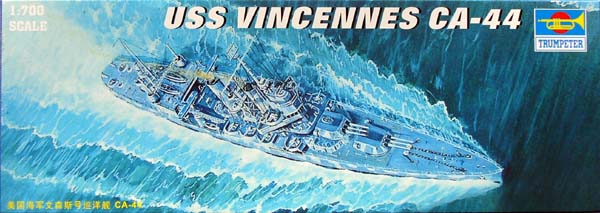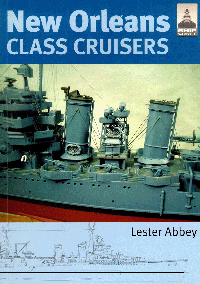
Reviewed by Lester Abby

| VINCENNES THE SHIP: | |
|
The Vincennes was the last ship completed of the New Orleans Class heavy cruisers. This class of cruisers were considered the most robust and effective of the US prewar cruisers. They performed heroically in wartime and three of the four most decorated cruisers in the war were of this class. The Vincennes career wasn't as illustrious as her sisters; she was sunk near Savo Island in her first surface engagement. She and her two sisters Astoria and Quincy were caught unprepared between two columns of Japanese cruisers and all three were sunk in the murderous crossfire. |
|
| APPEARANCE: | |
|
The New Orleans class could be divided into two major subclasses: The first five (which were by no means uniform) and the last two the Quincy and Vincennes. These two ships were visibly quite different from the preceding five ships in that their fore turret was moved back 9 and the deckhouse behind it cut back to the barbette to make room for it. The bridge differed in that it was lighter and smaller than the previous five ships as well as the stacks and searchlight towers. The most noticeable difference however was the shortened distance between the two fore turrets. This new kit by Trumpeter is very similar to the USS
New Orleans kit. Please refer to that review for an in depth look at
the sprues.
|
|
| THE KIT | |
|
Hull and deck: The kit comes with a split upper hull and an optional bottom hull. It can therefore be built as either full hull or waterline. It measure out perfectly and the shape appears to be the most accurate of any of the 1/700 kits. The stem is correct and the knuckle under the stern is captured perfectly. |
to enlarge |
| The hull has two rows of portholes with eyebrows molded
over the top row. The bottom row and some of the top would need to be filled
in to achieve a wartime appearance. Conversely some more portholes would
have to be added to the bottom for a peacetime appearance. The hull is
very nice and to scale the best of any of the 1/700 kits available.
The deck is also very nice with finely scribed lines and very thin splinter
shields.
The sheerline is captured very well in this kit. The eyebrows over the portholes give the hull some texture. The portholes should follow the sheerline. However the portholes are configured as in peacetime and the ones forward of the first turret will have to be filled in for a wartime appearance. |
|
| The kit comes with two weapons and accoutrements sprues. The 8 guns and turrets are well done with the gun barrels to scale and a very realistic blast bag molded on. There are two types of turrets the one used for the New Orleans, Astoria and Minneapolis with a rounded turret face and a flat face turret for the rest. The cranes are also well done although the lattice work would be better done in photoetch. The Mk 33 Gun directors too small and incorrectly formed the rangefinder should be at the front of the director. The 5, 40 mm 20 mm weapons are not well done. Admittedly the very small and fine detail parts are difficult to achieve in plastic many modelers prefer to use photoetch or aftermarket resin parts. The rafts and searchlight are acceptable and small plastic ladders are included. This is preferable to the Aztec steps found on so many plastic models but still not as good as photoetch. | |
|
The mainmast is not quite right. It has large supports for the yardarm when in fact there were none. The foremast has supports but they are overscale. The yardarm isn't attached aft of the mast as it should be but just sprouts off to the sides of the mast. This is common for most plastic kits however. |
 |
| The kit has a special sprues to reflect the differences
in the Quincys splinter shield and other parts unique to the last two
ships in this class. The bridge structures were well done for the Quincy
and Vincennes. The main deck part was done especially for these kits and
the most visible and important feature was omitted. The forward turret
is located in the same spot as for the other five ships not 9 scale feet
(4 mm) aft. Since the relative position of the fore turrets is visually
very obvious this must be fixed. The Capstans are also incorrectly located
they are too far aft. After going through all the trouble to make a new
main deck part with the correct splinter shield arrangement they miss the
most important point.
In spite of the very fine deck planking and excellent detail very little of this deck is accurate for the Vincennes; the location of the Anchor chains, Capstans, turret and splinter shields are all incorrect. |
|
|
To make things worse the splinter shields surrounding the secondary armament are correctly done for the Quincy but the Vincennes had very different shields. To make an accurate Vincennes the turret mounting would have to be moved back 4 mm, the capstans moved forward 4 mm and the anchor chain shortened and the existing splinter shields removed and semi circular ones scratchbuilt. |
 |
|
The bridge parts are for the most part accurate with the following minor points requiring fixing. The deck above the navigation bridge is not a full level in height. This positions the navigation rangefinder and the gun directors lower than they should be. |
|
| On the Vincennes the bridge windows, were narrowed, top to bottom.
This is not reflected in the kit, rather they reflect the Quincy bridge
windows.
The kit parts have the correct number and location of windows for the Quincy and Vincennes. These windows are correct for the Quincy but need to be narrowed from top to bottom for the Vincennes. |
|
|
The Vincennes had different the main battery directors. She was the last to complete, and was a contemporary of the early Brooklyn class. They shared similar directors. Alas the part in the kit is the same as for all of the other kits in this class. It isn't useful for either the first six of the class or the Vincennes. The searchlight tower is a plastic lattice rather than a monolithic plastic block as may be found on other plastic kits. It is still a bit thick and would better be replaced by photoetch. Still it allows a more realistic out of the box build. Another issue is that the stacks are common with the other kits however the stacks of the last two ships in this class were slightly smaller and more slender. This may not be obvious in a built up model unless it is compared to one of the other kits in the series. |
|
| INSTRUCTIONS | |
|
The instructions are complete and easy to follow. There is no painting guide but in the instructions there is a layout of the port side camouflage; unfortunately it is the pattern used on the Tuscaloosa and bears little resemblance to the actual pattern used on the Vincennes. The guide here is that of the Tuscaloosas camouflage which was different from the Vincennes. |
|
| Editors note:
Lester is the author of the latest Ship Craft book on New Orleans class Cruisers. I highly recommend that book if your building this kit. |
 |
| Conclusions: | |
|
After seeming so harsh on Trumpeter I actually like their kits. They make a good effort on their engineering, level of detail and, surprisingly accuracy. Their kits of the First four ships of this class are quite accurate. Its just that they let themselves down with some simple errors. In conclusion the basics of the kit are good as are many of the small parts. The kit suffers mainly from a major inaccuracy in the location of the front turret and configuration of the secondary armament splinter shields. It is disappointing that with all of the good things about this kit that there are these two simple but difficult to correct errors. |
|
